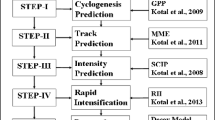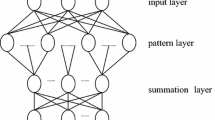Abstract
A statistical model for predicting the intensity of tropical cyclones in the Bay of Bengal has been proposed. The model is developed applying multiple linear regression technique. The model parameters are determined from the database of 62 cyclones that developed over the Bay of Bengal during the period 1981–2000. The parameters selected as predictors are: initial storm intensity, intensity changes during past 12 hours, storm motion speed, initial storm latitude position, vertical wind shear averaged along the storm track, vorticity at 850 hPa, Divergence at 200 hPa and sea surface temperature (SST). When the model is tested with the dependent samples of 62 cyclones, the forecast skill of the model for forecasts up to 72 hours is found to be reasonably good. The average absolute errors (AAE) are less than 10 knots for forecasts up to 36 hours and maximum forecast error of order 14 knots occurs at 60 hours and 72 hours. When the model is tested with the independent samples of 15 cyclones (during 2000 to 2007), the AAE is found to be less than 13 knots (ranging from 5.1 to 12.5 knots) for forecast up to 72 hours. The model is found to be superior to the empirical model proposed by Roy Bhowmik et al (2007) for the Bay of Bengal.
Similar content being viewed by others
References
Baik J J and Hwang H S 1998 Tropical cyclone intensity prediction using regression method and neural network; J. Meteor. Soc. Japan 76 711–717.
Chu J H, Sampson C R, Levine A S and Fukuda E 2002 The Joint Typhoon Warning Center Tropical Cyclone Best-Tracks 1945–2000; NRL Reference No. NRL/MR/7540-02-16.
DeMaria M and Kaplan J 1994 A Statistical Hurricane Intensity Prediction Scheme (SHIPS) for the Atlantic basin; Wea. Forecasting 9 209–220.
DeMaria M and Kaplan J 1999 An updated Statistical Hurricane Intensity Prediction Scheme (SHIPS) for the Atlantic and east North Pacific basins; Wea. Forecasting 14 326–337.
Emanuel K A 1999 Thermodynamic control of hurricane intensity; Nature 401 665–669.
Elsberry R L, Lambert T D B and Boothe M A 2007 Accuracy of Atlantic and eastern North Pacific tropical cyclone intensity forecast guidance; Wea. Forecasting 22 747–762.
Fitzpatrick P J 1997 Understanding and forecasting tropical cyclone intensity change with Typhoon Intensity Prediction Scheme (TIPS); Wea. Forecasting 12 826–846.
Geisler J E 1970 Linear theory on response of a two layer ocean to a moving hurricane; Geophys. Fluid Dyn. 1 249–272.
Hobgood J S 1998 The effects of climatology and persistence variables on the intensities of Tropical cyclone over Eastern North Pacific Ocean; Wea. Forecasting 13 632–639.
Houze R A, Chen S S, Smull B F, Lee W C and Bell M M 2007 Hurricane intensity and eyewall replacement; Science 315 1235–1238.
Jarvinen B R and Neumann C J 1979 Statistical forecast of tropical cyclone intensity; NOAA Tech. Memo. NWS NHC-10, 22 pp.
Kalsi S R 2005 Orissa super cyclone — A Synopsis; Mausam 57 1–20.
Kaplan J and DeMaria M 2003 Large scale characteristics of rapidly intensifying Tropical Cyclones in the North Atlantic Ocean; Wea. Forecasting 18 1093–1108.
Reynolds R W, Rayner N A, Smith T M, Stokes D C and Wang W 2002 An improved in situ and satellite SST analysis for climate; J. Climate 15 1609–1625.
Roy Bhowmik S K, Kotal S D and Kalsi S R 2007 An empirical model for predicting intensity of tropical cyclone over the Bay of Bengal; Nat. Hazards 41 447–455.
Schade L R and Emanuel K A 1999 The Ocean’s effect on the intensity of Tropical Cyclones: Results from a simple coupled atmosphere-ocean model; J. Atmos. Sci. 56 642–651.
Author information
Authors and Affiliations
Rights and permissions
About this article
Cite this article
Kotal, S.D., Roy Bhowmik, S.K., Kundu, P.K. et al. A statistical cyclone intensity prediction (SCIP) model for the Bay of Bengal. J Earth Syst Sci 117, 157–168 (2008). https://doi.org/10.1007/s12040-008-0006-1
Received:
Revised:
Accepted:
Published:
Issue Date:
DOI: https://doi.org/10.1007/s12040-008-0006-1




